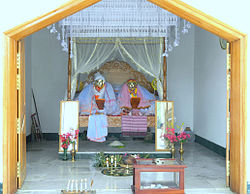Sanamahism
This article has multiple issues. Please help improve it or discuss these issues on the talk page. (Learn how and when to remove these messages)
|
 Ema Khunthok-haanbi, Guardian of Thangmeiband Area (Manipur, India) | |
| Total population | |
|---|---|
| approx.235,000[1] | |
| Regions with significant populations | |
| Manipur, India | |
| Scriptures | |
| Puya / written in Meitei Mayek (Manipuri) |
Sanamahism or Sanamahi Laining refers to the traditional Meitei beliefs and religion found in the northeastern Indian states near Myanmar. The term is derived from Sanamahi, one of the important Meitei deities. According to Bertil Lintner, Sanamahism is an "animistic, ancestor worshipping, shaman-led tradition".[2]
Sanamahism is practiced by the Meitei, Zeliangrong and other communities who inhabit Manipur, Assam, Tripura, Myanmar and Bangladesh, with small migrant populations in the United Kingdom, United States, and Canada.
Revival
According to 2011 census, about eight percent of Manipur belong to religions stated as 'other'.
Religion in Manipur is thought to have passed through three stages.[3]
Form of worship
In assimilate features such as the worship of forces of nature like fire, water, mountain, ancestor worship (Apokpa), Lamlai (Outdoor Dwelling Gods and Goddesses), Yumlai (House dwelling Gods and Goddesses), Ningthoulai (King God) and Umanglai (Forest Dwelling God). Religion of antiquity – in its pure native form, it is as all as the history of Meetei/Meitei people from the time immemorial.
Deities
There is reference to the worship of Sanamahi by Ningthou (King) Kangba in the Hayi age. Manipur is a polytheistic land with Atiya Sidaba as the supreme god. Atiya Sidaba, Apaanba and Asheeba are the three manifestations or incarnations of God as the creator, the preserver and the annihilator of this universe respectively.
Panthoibi is the Mother of the Universe and Nongpok Ningthou is her mate.[4] Besides those, three hundred and sixty-four deities with their consorts are the most important deities worshipped by the Meiteis.
The Plain Kabui are observed in worship of Sanamahi and Ima Leimarel.[5]
Sanamahi (also known as Asheeba) has a creator brother (like him) named Paakhangba (Konjin Tukthapa).[6]
Some of the important gods and goddesses worshiped by the Meiteis are:[citation needed]
- Shidaba Mapu (Immortal Owner)
- Lainingthou Sanamahi (Supreme God of the Household Gods and Goddesses)
- Ebudhou Paakhangba (Younger Brother of Lainingthou Sanamahi and the Ruler of the outside world)
- Ima Leimarel Sidabi
- Apokpa (Prime Ancestor God and Goddess, different according to different surnames)
- Ebendhou Emoinu (Goddess of prosperity, wealth and kitchen)
- Ema Panthoibi (goddess of valor and battle)
- Yumjao Lairembi (Household Goddess)
- Ema Phouoibi (Goddess of Bounty)
- Ebudhou Marjing (God of sports and also the protector of North-East Direction)
- Ebudhou Thangjing (God of power and also the protector of South-West Direction)
- Ebudhou Wangbrel (God of rain, death and also the protector of South-East Direction)(Kumar 2004, 92)
- Ebudhou Koubru (God of strength and also the protector of North-West Direction)
They also worshipped the Umanglais (forest dwelling gods and goddesses). Umanglais are the protectors, preservers of their corresponding areas/localities which includes houses, fields, welfare of the people, etc. In short, the Umanglais are the guardians of the outer world of the people and also these gods and goddesses are associated with each and every doings of the people in day-to-day life. Hence, They are considerrd to be very powerful.
Some of the Umanglais are:[citation needed]
- Lainingthou Nongshaaba
- Lainingthou Puthiba
- Lainingthou Awaangba
- Lainingthou Marjing
- Lainingthou Khoiriphaaba
- Ema Khunthok-haanbi
- Ema Haoreima Sampubi
- Ema Eereima
- Ekop Ningthou
- Thoubal Ningthou
- Ema Kondong Lairembi
- Nongpok Ningthou
- Langol Ningthou
- Ema Langol Lairembi
- Ebudhou Naothingkhong Paakhangba
- Ebudhou Khamlaangba
- Ebudhou Oknarel
- Ebudhou Thangnarel
- Ebudhou Yangoiningthou
The title "Lainingthou" refers to the incarnation from Lainingthou Sanamahi and the title "Ebudhou" refers to the incarnation from Ebudhou Paakhangba.
Offerings
Meiteis offer praying to the household gods and goddesses twice a day, once at dawn and once at dusk. They offer incense sticks/burner and candles/meiraa along with flowers and water.
Devout Meiteis offer food at sacred spots daily to the goddess of kitchen and prosperity, Ebendhou Emoinu.[7]
See also
References
- ^ 2001 Census
- ^ Bertil Lintner (2015). Great Game East: India, China, and the Struggle for Asia's Most Volatile Frontier. Yale University Press. p. 113. ISBN 978-0-300-19567-5.
- ^ P. 199 Social Movements in North-East India By Mahendra Narain Karna
- ^ P. 4290 Encyclopaedia of Indian Literature By various
- ^ People of India By Kumar Suresh Singh, S. B. Roy, Asok K. Ghosh
- ^ P. 82 A History of Manipuri Literature By Ch Manihar Singh
- ^ P. 62 Feminism in a traditional society by Manjusri Chaki-Sircar
Bibliography
- Kshetrimayum, Otojit (2014), Ritual, Politics and Power in North East India: Contextualising the Lai Haraoba of Manipur, Ruby Press & Co., ISBN 978-93-82395-50-8
- Hodson, T.C. (2015), The Meitheis, Ruby Press & Co., ISBN 978-93-82395-56-0
- Singh, Dr. Saikhom Gopal (2015), The Meeteis of Manipur: A Study in Human Geography, Ruby Press & Co., ISBN 978-93-82395-21-8
- Singh, Dr. Saikhom Gopal (2015), Population Geography of Manipur, Ruby Press & Co., ISBN 978-93-82395-25-6
